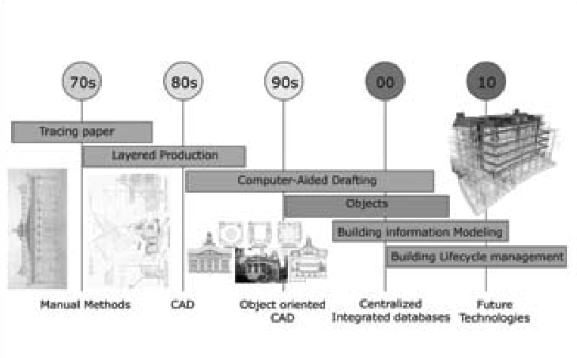

SIGNIFICANCE OF BIM
BIM is a powerful tool that gives visual coordination of all the elements in the 3D model & identifies the inconsistencies between the building systems. The system is configured to foresee the collision of two elements in the same spot during the designing stage to save the project budget cost, work revision, timeline & risk mitigation. With the Indian construction market undergoing a paradigm shift towards the adaptation of technology, the public and private sectors are engaging actively with BIM. By merging the 3D aspect of BIM with some additional parameters like Cost, Time & Project lifestyle management, it can create a 6-dimensional model which can help maintain the project updates along all its stages through a single platform for all the project stakeholders. BIM can lead in proving a major aid for the revolutionary construction projects outlined for society.
EVOLUTION OF BIM
With a transition of phase through decades in the building designing, and integrating process as reflected in Fig.1, the designing firms today are willing to step up to take this revolutionary technique. The designing skills from traditional 2D-based drawings have advanced to time & reality-based multidimensional models, which reflect the building behavior, and energy consumption in their designing stage. BIM software gives the 2D designs an interactive building representation models of the conventional coordinated lines and drafting techniques. This proves as the match of modern-day revolution.
Figure 1 Schematic diagram representing the evolution of Architectural drawings. (Mukherjee, 2009)

Figure 1 Schematic diagram representing the evolution of Architectural drawings. (Mukherjee, 2009)
ADOPTION OF BIM
Based upon a Survey conducted by BIM enthusiast J. Vinoth Kumar in Roorkee, India, the Indian construction firm owners have volunteered to adopt a remarkable 87% for adopting BIM to their firms. With the incorporation of Autodesk Revit as the BIM application, about 49% of respondents in their survey accepted it as their significant BIM tool. (Mukherjee, 2009)
Another survey was conducted by using the Mixed method approach of international research by G. M. Jagadeesh & Dr Sharmila Jagadisan in some major cities of India like Delhi, & Mumbai. As per the survey, 48% of the Indian construction sector is aware of BIM Technology. The following table outlines the types of construction projects executed using BIM. (Jagadisan, 2019)
| Type of Project | % |
| Residential | 40 |
| Commercial | 22 |
| Institutional | 18 |
| Industrial | 7 |
| Mixed-Use | 13 |
THE BENEFITS OF BIM TO THE INDIAN CONSTRUCTION SECTOR:
BIM has gained significant popularity worldwide, especially in India, by the public & private sectors. Implementation of BIM can remove the hurdle factors such as adversarial relations, low productivity rates, high rates of inefficiency & reworks, frequent disputes & lack of innovation, resulting to cost or time overruns in their projects.
Some of the promising benefits of using BIM in the Indian construction industry are:
- Project real view
- Elimination of the Unbudgeted changes
- Cost Monitoring
- Streamlines work
- Potential conflict resolution using clash detection.
BIM has recorded a saving of over $2 billion in just one year in the public sector of the UK. After a targeted and well-channeled implementation of BIM in construction in India, there can be proven convenience Rs. 5.97 Trillion of investment in upgrading the infrastructure this financial year 2021.
Author’s Comments:
BIM is a revolutionary technology for the Indian construction sector, which can also prove a great aid to engage in the Digital India Scheme launched by current PM Narendra Modi. Simultaneously, it also serves a new vision for the Indian Construction market, which once adapted appropriately can be proven to give 3Es- Economical, Environmental & Effective by reducing the human activity and making employment openings to the new age graduates.
References:
- Jagadisan, G. M. (2019, November). International Journal of Engineering Research & Technology. Retrieved from www.ijert.com: https://www.ijert.org/research/investigation-of-bim-adoptionin-india-IJERTV8IS110124.pdf
- Mukherjee, J. V. (2009, December 2). Researchgate. Retrieved from www.researchgate.com: https://www.researchgate.net/publication/41037221_Scope_of_Building_Information_Modelin g_BIM_in_India
